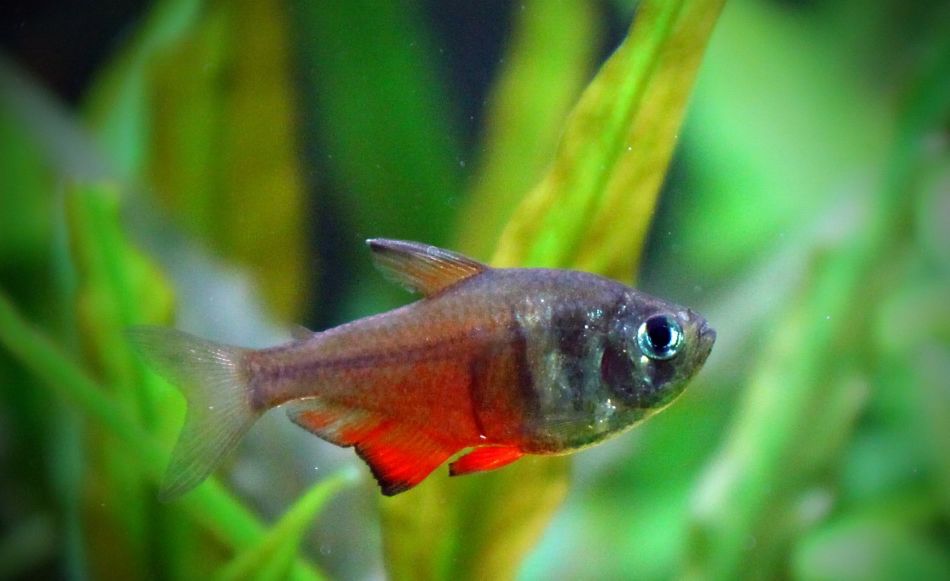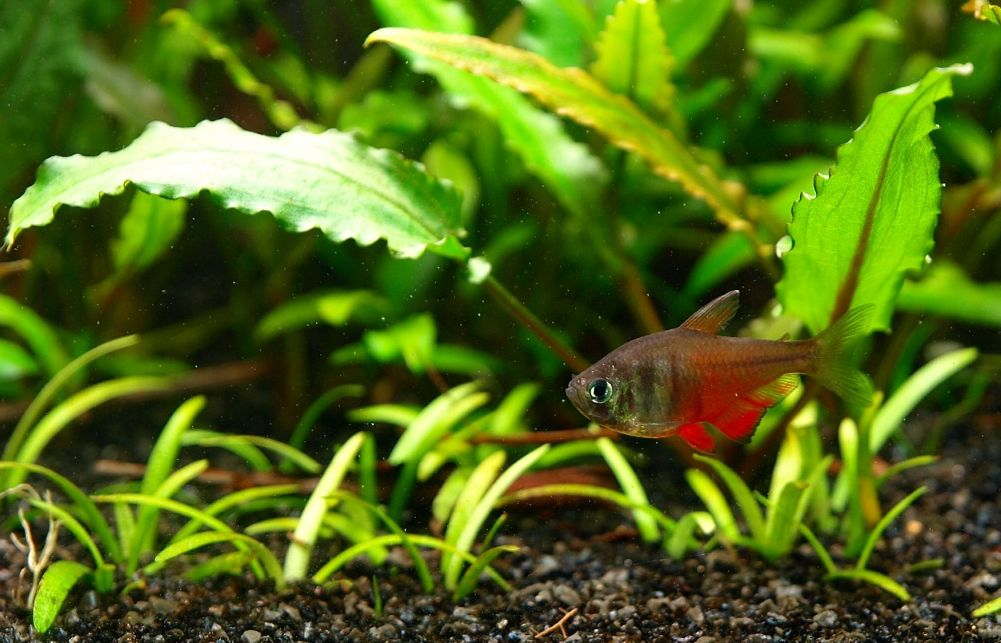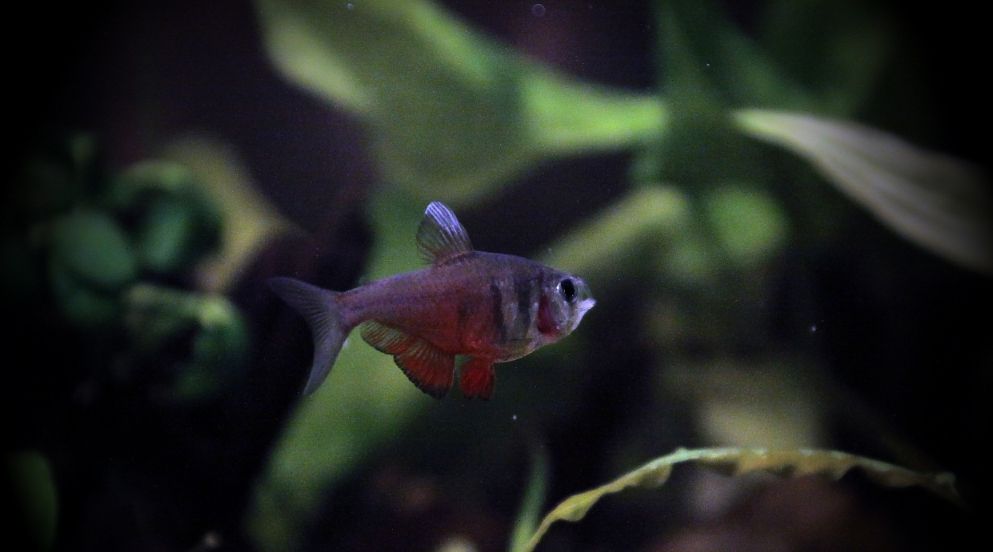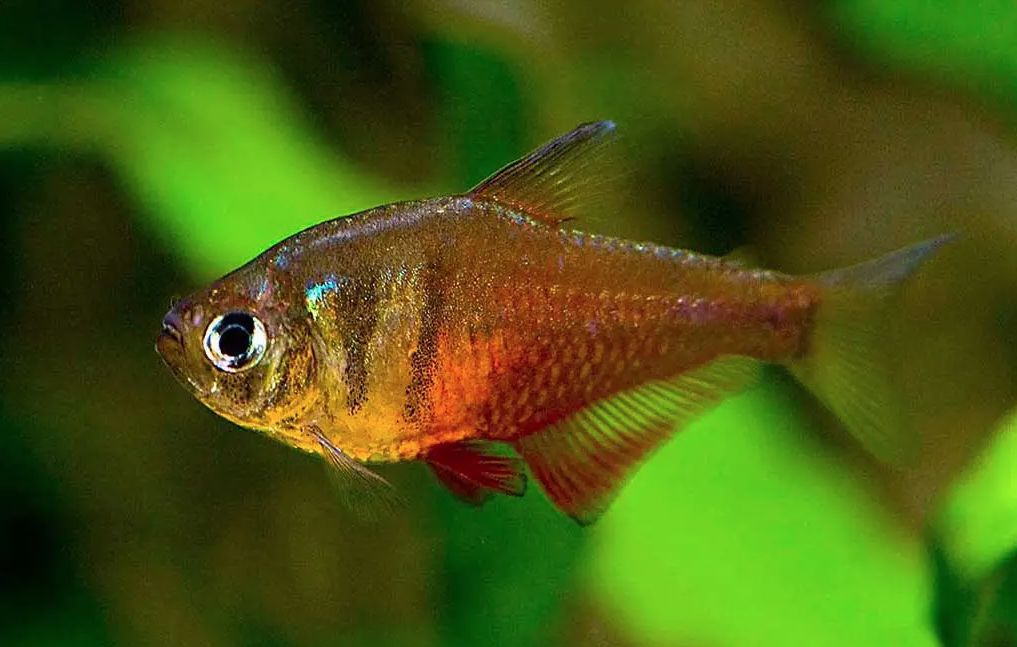The flame tetra (Hyphessobrycon flammeus), also known as the von rio tetra or the fire tetra, belongs to the family Characidae. Flame tetra is a bright colored freshwater aquarium fishy. In pet shops the fish species quite often have pale coloring due to the high level of stress they are exposed to there. However, when you bring them home and create favorable conditions, their coloring becomes bright again.

Contents
Habitat in the wild
The Characidae family is one of the largest fish families and includes a wide range of species found in freshwater habitats in South America. Hyphessobrycon genus includes over 40 small fish kinds dwelling in Amazon River basin. All representatives of the genus have no scales at the bottom of their caudal fin. Hyphessobrycon: comes from ancient Greek – hyphesson, which means “small sized”. In this case the word is used as a prefix plus the general name Brycon. From Latin Flammeus means «flame color».
The flame tetra inhabits in South America, specifically in the upper Paraguay River basin. They are native to regions in Brazil, Paraguay, and Argentina. It dwells in coastal waters with water temperature within the range from 22 to 28 °C (72–82 °F), pH 5,8—7,8 and water hardness within 5—25 °dH.
Rivers where the fish inhabits flow though one of the most heavily populated and industrialized regions of Brazil, which ecology suffered a lot due to building of barrages and drains, water pollution, presence of introduced species (including over 40 introduced fish species only in Paraíba do Sul) and other forms human-induced degradation.
The latest scientific data obtained from the area around Rio-de-Janeiro dates back to 1992 and since then the presence of this fish species haven’t been registered in the region. Though, it doesn’t mean that the fish is extinct, since 2004 H. flammeus has been included into Brazilian national red list.
The flame tetra prefers small and shallow (less than 50 cm deep) slow flowing and thickly planted tributaries and streams. Flame tetra habitat is usually in clean, transparent or brownish water with sandy bottom. In the wild this fish is a schooling one, so it lives in small groups. Flame tetra feeds on worms, small insects and crustaceans as well as various plant food. In their natural habitat, they form tight-knit groups among vegetation, which provides them with security and protection. They are omnivorous and feed on a variety of small invertebrates, zooplankton, and plant matter.
Description
Flame Tetras (Hyphessobrycon flammeus) are relatively small fish. On average, they grow to a size of about 1.5 inches (3.8 centimeters) in length. Males and females are generally similar in size, with no significant differences between the sexes in terms of size or appearance. Their small size makes them suitable for smaller aquarium setups or community tanks where space may be limited. Due to their small size, flame tetras are often kept in groups to create a visually appealing display and to promote their natural behavior.
The average lifespan of flame tetras in captivity is typically around 3 to 5 years. However, with proper care and optimal conditions, they can sometimes live up to 6 years or even longer.
The fish has body shape is typical for all tetra species – it is tall and flattened from sides with large anal fin extending beyond the fish dorsal fin.
The prevailing coloring pattern of the fish is brown and olive-green one. The front side of the fish body is silvery, sometimes with yellowish sheen. There are 2-3 vertical dark stripes behind the fish head, they don’t reach the fish back and abdomen. The fish body from its dorsal to the bottom of the caudal fin is colored in various tints of red (from pale pink to bright red). Other fish fins have the same coloring except the pectoral and fatty ones which are transparent. There is a thin dark stripe on the fins edge, which becomes coal-black during the fish spawning period.
Environment where the fish lives and its current state have high impact on the fish coloring.
Provided with the most favorable conditions with overhead lighting tetras look bright and gorgeous. However, even tiny stress or improper tank conditions lead to the fish coloring change – it fades and looses most of its attractiveness.
Except the decorative value flame tetra is also of some interest in terms of line breeding. Is one of those few fish kinds that nowadays successfully undergo their coloring enhancement by means of hormone administration.
The suitable substance is given to the fish with food or it is dissolved in the tank water. As a result of such exposure the fish coloring becomes brighter and more saturated. Even the fish juveniles coloring becomes as bright and intense as that of the reproductive fish species.
Along with the visible effect this approach also has some drawbacks. Thus, vital capacity of the fish species which coloring was artificially enhanced decreases and as a result their death rate increases.
Hormones used for artificial coloring enhancement don’t influence the fish reproductive function. Therefore, the breeders stay the same active and the quality of their offspring remains the same as it was before using the substances containing hormones.
| Characteristic | Description |
|---|---|
| Common Name | Flame Tetra, Von Rio Tetra, Fire Tetra |
| Scientific Name | Hyphessobrycon flammeus |
| Family | Characidae |
| Origin | South America (Brazil, Paraguay, Argentina) |
| Size | Approximately 1.5 inches (3.8 centimeters) |
| Lifespan | Average 3 to 5 years (can live up to 7 years or longer) |
| Water Parameters | Temperature: 72°F – 82°F (22°C – 28°C) |
| pH: 5.0 – 7.0 | |
| Water Hardness: Soft to slightly acidic | |
| Behavior | Peaceful, shoaling fish |
| Diet | Omnivorous, feeds on small invertebrates and plant matter |
| Compatibility | Generally compatible with other peaceful fish |
| Sexual Dimorphism | Minimal, females may appear slightly larger and have a rounder belly when carrying eggs |
| Breeding Behavior | Males exhibit more vibrant coloration, become territorial, and actively court females |
| Recommended Tank Size | At least 10 gallons for a small group |
| Tank Setup | Well-planted with hiding spots and open swimming areas |
| Special Considerations | Provide a balanced diet and maintain good water quality |

Difficulties in keeping
The success of flame tetra in aquarium hobby is due to the fact how easily it adapts to various tank conditions as well as to its relative persistence to diseases. The fish is quite often recommended to beginner aquarists.
As many other fish kinds which in the wild inhabit in untouched, virgin areas, flame tetra can’t stand any accumulation of organic substances in a tank and requires clean tank water. This means that weekly water renews are part of your routine here. Another thing you have to keep in mind is, that you should put tetras only into a tank with a stable biological balance in it.
Keeping in a tank
Water parameters
The flame tetra is rather undemanding. Tank conditions for it are quite simple to create and maintain, since they resemble those at which the fish lives in the wild.
Tank water temperature should be within the range of 22 to 28 °C (72–82 °F), pH 5,8—7,8 and water hardness from 5 to 25 °dH. Though, during the commercial breeding flame tetra has adapted to various tank water parameters including hard water.
It is important to keep the tank water clean and fresh. For this purpose you should regularly renew it and install a water filter.
Excessive content of poisonous nitrogen compounds in the tank water caused by large amount of rotting organic substances is fatal for the fish: it becomes anxious, looses appetite, and quite frequently tries to jump out of the tank.
Tank size
You should keep tetras in a school of at least 7 species. For a small group of flame tetras, a minimum tank size of 10 gallons (38 liters) is generally recommended. However, keep in mind that a larger tank is always beneficial, as it provides more swimming space, stability, and room for additional tank mates.
If you plan to keep a larger school or include other compatible fish species in a community setup, it is advisable to opt for a larger aquarium. A 20-gallon (75-liter) tank or larger would be more suitable to accommodate a school of flame tetras along with other fish. The larger is the fish school, the more spacious their tank should be.
Providing adequate swimming space, along with plants, driftwood, and hiding places, is important for flame tetras. They appreciate a well-structured tank with areas for exploration and retreat. Additionally, maintaining good water quality and performing regular maintenance are essential for their overall health and well-being.
Tank decor
The flame tetra looks especially appealing in tall thickly planted tanks. When decorating a tank you should foresee some free space for the fish to swim. You can create small glades among the aquarium plants, so it will be seen how the fish school swims through the front glass of the tank.
Males should prevail in such a group, since they are much brighter colored than females. Use thickly growing aquarium plants as tank decorations. Place them along the tank walls to leave the space for flame tetra to swim.
It is desirable to put dry leaves on the tank bottom. They will make the tank water light brown and it will look like tetra natural habitat. You should replace the leaves once in two weeks, which can be done together with water renews.
Substrate
The substrate choice depends on personal preference, the needs of your Flame Tetras, and the type of aquascape you wish to create. Using fine gravel or sand as a substrate is a common choice for flame tetra tanks. It provides a natural appearance and allows for easy maintenance.
Diet
Flame tetra is omnivorous fish that have a relatively varied diet. In the wild it feeds on small spineless species, crustaceans, filamentous algae, organic detritus, etc.
In a tank the fish can live feeding on artificial aquarium fish food. A staple part of their diet can consist of high-quality flake or pellet foods specifically formulated for tropical fish. Look for options that contain a mix of animal protein (such as fish or shrimp) and plant-based ingredients.
Flame tetra like most of tank fishes it’d prefer more diversified diet containing live and frozen blood worm, tubifex, daphnia, etc. These foods are rich in protein and can be offered as occasional treats. It’s essential to feed flame tetras small amounts of food multiple times a day, rather than a large amount at once, to prevent overfeeding and maintain good water quality. Observing their behavior and adjusting the amount of food accordingly can help ensure they receive the appropriate portions.

Tank mates
Are flame tetras aggressive or fin nippers? No. Flame tetras are generally peaceful fish that can coexist with a variety of compatible tank mates. However, it’s important to consider their relatively small size and gentle nature when selecting tank mates to ensure a harmonious community aquarium. Here are some suitable tank mates for flame tetras:
- Harlequin Rasboras (Trigonostigma heteromorpha)
- Neon Tetras (Paracheirodon innesi)
- Ember Tetras (Hyphessobrycon amandae)
- Glowlight Tetras (Hemigrammus erythrozonus)
- Black Neon Tetras (Hyphessobrycon herbertaxelrodi)
- Cardinal Tetras (Paracheirodon axelrodi)
- Rummy Nose Tetras (Hemigrammus rhodostomus)
- Dwarf Gouramis (Trichogaster lalius or Trichogaster chuna)
- Sparkling Gouramis (Trichopsis pumila)
- Celestial Pearl Danios (Danio margaritatus)
- White Cloud Mountain Minnows (Tanichthys albonubes)
- Dwarf Rasboras (Boraras spp.)
- Endler’s Livebearers (Poecilia wingei)
- Guppies (Poecilia reticulata)
- Platies (Xiphophorus spp.)
- Corydoras Catfish (Corydoras spp. – pygmy cory, panda cory, adolfoi catfish)
- Otocinclus Catfish (Otocinclus spp.)
- Bristlenose Plecos (Ancistrus spp.)
Never keep tetra with large sized fishes (oscar fish, jaguar cichlid, green terror, convict cichlid, Jack Dempsey fish).
The fish prefers a company of 7 and more species. In this case it feels safer and less stressed. Another thing is, that when the fish lives in a school it’s easier to observe its natural behavior as well as a hierarchy inside the group.
In community aquariums, maintaining a ratio of multiple females to each male can help reduce aggression and promote a more balanced and harmonious environment. However, for a typical community setup, sexing individual flame tetras is not always crucial, as their peaceful nature allows them to coexist well regardless of their gender.
Gender differences: male vs female
Distinguishing between male and female flame tetras can be challenging, as they exhibit minimal sexual dimorphism. However, there are a few subtle characteristics that can help differentiate between the sexes:
- Size: Body of adult males as a rule is less tall than than of the females. The flame tetra male species are also a bit smaller, but their coloring is brighter and more saturated than that of the female fish.
- Coloration: The fish males are bright and appealing. The red color of their fins smoothly transforms into ruddy one. A black stripe goes along the lower edge of the anal fin of male and it is completely absent on the female species anal fin. Males have black tips of their abdominal fins and transparent caudal ones, while the female fish species have it colored in pink. However, this distinction may not always be easily noticeable.
- Behavior: During breeding behavior, males may exhibit more vibrant coloration and become more territorial and active, actively courting and chasing females. However, this behavior can be subtle and may not always be easy to observe.

Breeding
Provided with proper feeding and care females become reproductive at the age of 6-8 months and the males – at the age of 8-12 month, correspondingly.
Females and males should be kept separately for a week before spawning. It can be done by separating the tank into two sections with a net or other kind of separator or you can put the breeders into different tanks. During this period of time you should feed the flame tetra high with live food.
The main condition of successful spawning is to prepare the tank water properly. This is what should be done in advance, at least one week before the spawning starts.
You should mix tap water and distilled or osmotic water in equal proportion; then add peat extract into the mixture (in an amount of 20 drops for each 10 liters of water).
Hardness of spawning water has should be about 4—4,5 dGH and it should be slightly acidic pH 6,0—6,5.
Use glass tanks of at least of 5 liters (1 US gal) capacity as spawning tanks.
Spawning tank should be illuminated with a lamp with energy equivalent to 25 W installed at the distance of 20—30 cm from the tank. Tank water temperature should be maintained at about 25—26 °C. To protect eggs put a separation net or a bush of a small leaved tank plant on the spawning tank bottom.
Instead of live tank plants you can use bathing sponge mesh puff. In 6-12 hours after you put flame tetra into the spawning tank, the female fish lays up to 500 small sticky eggs.
Once the spawning is over, you should remove the flame tetra from the spawning tank and decrease the water level up to 10 cm; add several drops of methylene blue solution and turn on slight water aeration.
At water temperature about 26 °C, in about a day larvae start to hatch from the eggs. The larvae are tiny, but rather active. At first, they lie on the tank bottom, on the second day they stick to the spawning tank walls; quite often close to the water surface. On the 4-5th day the larvae turn into juveniles and start to swim. Since then you can start to feed them.
Starter feed can be the following: cyclops nauplii, infusorian, egg yolk. If there is not enough food, the fish juveniles die quickly.
Juveniles are demanding in terms of oxygen content. Therefore, additional water aeration is required in case of a tank with small surface area.
Only in a week you can start feeding the flame tetra juveniles with brine shrimp nauplii, cyclops and powdered dry food. Further juveniles feeding is of no trouble.
Juveniles grow very quickly: they become 1 cm long just in 3 weeks. At this age the juveniles go through full metamorphosis and become small copies of the adult fish species.
As the flame tetra juveniles grow you should put them into larger tanks with filtration and aeration. To avoid cannibalism among the juveniles you should sort them according to their size.
Every day you should remove food leftovers and other organic waste from the tank as well as add some fresh water, but not more than 5% of the total water amount.
When the juveniles are 1 month old you can add plant components into their diet. Considering the fact, that tetras are prone to overeating you should limit feeding them with water-swellable food for aquarium fish.